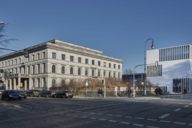
Anyone with a special talent for jazz music, ballet, acting or conducting can make their hobby a profession at the University of Music and Performing Arts Munich – if you manage to get through the strict selection process. But the building in the Maxvorstadt district used to serve a completely different purpose …
The Hochschule für Musik und Theater in Munich is one of Germany’s largest universities in the cultural sector. It may have only got its current name in 1998, but the institution was founded as the “Königliches Conservatorium für Musik” (Royal Conservatory for Music) way back in 1846.
While the university’s theatrical courses are taught at the Prinzregententheater (Prince Regent Theatre), the Ballet Academy can be found on Wilhelmstrasse. The Hochschule für Musik und Theater also has teaching facilities on Luisenstrasse and at the Gasteig cultural centre, but its headquarters are located in the former Nazi “Führerbau” (“Führer’s Building”) on Arcisstrasse in Maxvorstadt district. The building was designed by the architect Paul Ludwig Troost and constructed for Adolf Hitler for representational purposes between 1933 and 1937. The air-raid shelter was used by the Nazis to hide all kinds of stolen art.
In 1945, the US military government started to use the building as a central collection point for looted art, including Göring’s art collection. This is where works that hadn’t been destroyed were identified and returned to their rightful owners. The building’s former congress hall was converted into a concert hall in 1954.
The university educates around 1,000 students across eleven institutes and academies in all artistic and pedagogical music professions and dance. Special attention is paid to culture and music management, music journalism and theatrical professions, and the university works closely with the Theaterakademie August Everding (August Everding Theatre Academy).
The university has institutes for school music, church music, jazz, new music, composition and conducting. There are also courses in artistic singing and theatre education, artistic instrumental studies in the fields of woodwind and brass, strings, plucked instruments, percussion and chamber music. Numerous renowned choirs, ensembles and orchestras are permanent fixtures at the university.